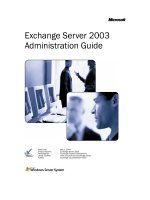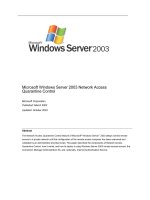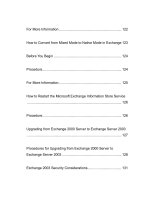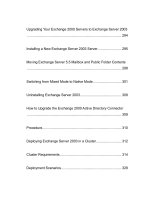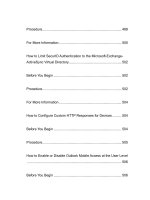Tài liệu Microsoft Exchange Server 2003 Administration Guide pdf
Bạn đang xem bản rút gọn của tài liệu. Xem và tải ngay bản đầy đủ của tài liệu tại đây (4.57 MB, 503 trang )
Exchange Server 2003
Administration Guide
Valid Until: May 1, 2004
Product Version: Exchange Server 2003
Reviewed By: Exchange Product Development
Latest Content: www.microsoft.com/exchange/library
Author: Exchange Documentation Team
Exchange Server 2003
Administration Guide
Jyoti Kulkarni
Patricia Anderson
Published:
September 2003
Applies To:
Exchange Server 2003
Copyright
Information in this document, including URL and other Internet Web site references, is subject to change without notice. Unless
otherwise noted, the example companies, organizations, products, domain names, e-mail addresses, logos, people, places and events
depicted herein are fictitious, and no association with any real company, organization, product, domain name, e-mail address, logo,
person, place or event is intended or should be inferred. Complying with all applicable copyright laws is the responsibility of the user.
Microsoft may have patents, patent applications, trademarks, copyrights, or other intellectual property rights covering subject matter in
this document. Except as expressly provided in any written license agreement from Microsoft, the furnishing of this document does not
give you any license to these patents, trademarks, copyrights, or other intellectual property.
© 2003 Microsoft Corporation. All rights reserved.
Microsoft, Active Directory, ActiveSync, MSDN, MS-DOS, Outlook, Visual Basic, Visual C++, Visual Studio, Win32, Windows,
Windows Mobile, Windows NT and Windows Server are either registered trademarks or trademarks of Microsoft Corporation in the
United States and/or other countries.
The names of actual companies and products mentioned herein may be the trademarks of their respective owners.
Acknowledgments
Project Editor: Olinda Turner
Contributing Writers: Tammy Treit, Teresa Appelgate, Jon Hoerlein, Joey Masterson, Christopher Budd
Contributing Editors: Lindsay Pyfer, Diane Forsyth, Cathy Anderson, Alison Hirsch, Tony Ross, Lee Ross
Technical Reviewers: Amanda Langowski, Brad Owen, James O'Brien, Eric Dao, Brian Holdsworth, Max Ciccotosto, Simon Attwell,
Wayne Cranston, Pretish Abraham, Khyati Vyas, Scott Landry, Aidan Delaney; Evan Dodds, Ryan Hurey; Ladislau Conceicao, Michael
Lee, Julian Zbogar-Smith, Jeetendra Falodia, Dave Whitney, Andrew Moss, Chris Ahlers, David Emmick, Catalin Stafie, Jaya Matthew
Graphic Design: Kristie Smith
Production:
Sean Pohtilla, Joe Orzech
Table of Contents
Introduction
Overview .......................................................................................................... 1
What Will You Learn from This Book?....................................................................................1
Who Should Read This Book? ................................................................................................2
Terminology .............................................................................................................................2
How is This Book Structured? ................................................................................................3
What Are the Requirements to Complete the Procedures In This Book? ............................5
Chapter 1
Preparing to Administer Exchange Server 2003 ......................................... 7
Understanding Exchange Administration Architecture .........................................................8
Interacting with Active Directory......................................................................................9
Selecting the Right Management Tools....................................................................... 11
Working with Exchange System Manager........................................................................... 12
Working with Active Directory Users and Computers......................................................... 14
Creating Recipients....................................................................................................... 16
Performing Exchange Tasks ......................................................................................... 17
Managing Exchange in Multiple Domains ................................................................... 18
Deciding Where to Manage Exchange ................................................................................ 18
Setting Up a Management Station............................................................................... 19
Using Custom Consoles ....................................................................................................... 22
Creating Custom Consoles ........................................................................................... 24
Automating Administrative Tasks........................................................................................ 25
ii Exchange Server 2003 Administration Guide
Chapter 2
Managing an Exchange Organization.........................................................27
Promoting an Exchange Organization from Mixed Mode to Native Mode ........................ 28
Applying Global Settings ...................................................................................................... 30
Associating File Name Extensions with MIME............................................................. 30
Using SMTP Policies to Control Outbound Mail Formatting
and Automatic Responses............................................................................................ 32
Selecting Message Delivery and Message Filtering Options...................................... 36
Creating and Managing Administrative Groups.................................................................. 44
Understanding the Types of Administrative Models ................................................... 45
Displaying Administrative Groups ................................................................................ 50
Creating Administrative Groups ................................................................................... 51
Moving Objects Between Administrative Groups ........................................................ 51
Deleting Administrative Groups ................................................................................... 52
Using System Policies .......................................................................................................... 52
Understanding How System Policies Affect Individual Settings ................................. 54
Creating a Server Policy................................................................................................ 55
Adding Servers to a Server Policy ................................................................................ 57
Viewing the Objects Controlled by a System Policy..................................................... 57
Copying System Policies Between Administrative Groups.......................................... 58
Modifying or Removing a Policy ................................................................................... 59
Managing Permissions ........................................................................................................ 60
Understanding Exchange Objects and Exchange System Manager .......................... 60
Chapter 3
Configuring Exchange Server Settings.......................................................67
Configuring Server-Specific Settings................................................................................... 68
Viewing Messages in Message Tracking Center ................................................................ 69
Enabling Message Tracking................................................................................................. 69
Managing Message Tracking Log Files........................................................................ 70
Designating a Front-End Server .......................................................................................... 71
Sending Error Information to Microsoft .............................................................................. 72
Configuring Language Settings ........................................................................................... 73
Scheduling Mailbox Manager Processes............................................................................ 74
Defining a Schedule...................................................................................................... 76
Setting Reporting Options ............................................................................................ 76
Configuring Diagnostics Logging on a Server..................................................................... 77
Table of Contents iii
Customizing Public Folder Referrals ................................................................................... 80
Assigning Costs on the Public Folder Referrals List.................................................... 82
Understanding Directory Access Options............................................................................ 83
Automatically Constructing a Topology for Directory Access...................................... 85
Manually Constructing a Topology for Directory Access ............................................. 86
Viewing System Policies Applied to the Server................................................................... 87
Setting Server-Specific Permissions ................................................................................... 89
Configuring System Resource Usage During Full-Text Indexing ........................................ 90
Chapter 4
Managing Recipients and Recipient Policies............................................93
Understanding Recipients ................................................................................................... 93
Understanding Recipient Policies ....................................................................................... 96
Managing E-Mail Addresses ......................................................................................... 97
Managing Mailboxes Using Mailbox Manager............................................................. 99
Creating Recipients............................................................................................................ 101
Mailbox-Enabled and Mail-Enabled Recipients......................................................... 102
Mail-Enabled Groups ..................................................................................................104
Understanding Query-Based Distribution Groups ............................................................107
Query-Based Distribution Groups Described.............................................................107
Modifying Exchange 2000 SP3 Servers for Use with Windows 2000 Global
Catalog Servers...........................................................................................................108
How Query-Based Distribution Groups Work.............................................................109
Deployment Recommendations for Query-Based Distribution Groups....................109
Guidelines for Creating Query-Based Distribution Groups .......................................111
Creating Query-Based Distribution Groups................................................................112
Combining Multiple Query-Based Distribution Groups .............................................114
Managing Recipients .........................................................................................................115
Notes for Exchange 5.5 Administrators.....................................................................115
Managing Recipients with Recipient Policies............................................................116
Managing Recipient Settings.............................................................................................120
Configuring Message Settings for Mailbox-Enabled Recipients...............................121
Exchange Advanced Settings for Mailbox-Enabled Recipients ................................ 123
Configuring Message Settings for Mail-Enabled Recipients.....................................127
Distribution Groups.....................................................................................................128
iv Exchange Server 2003 Administration Guide
Understanding Address Lists.............................................................................................129
Address Lists Described .............................................................................................130
Creating Address Lists ................................................................................................131
Offline Address Lists ................................................................................................... 134
Customizing the Details Templates ........................................................................... 136
Recipient Update Service ..................................................................................................138
Chapter 5
Understanding and Configuring Message Routing and Transport ....... 141
Configuring Routing for Internal Mail Flow .......................................................................141
Understanding Routing Groups..................................................................................142
Creating Routing Groups ............................................................................................146
Moving Servers Between Routing Groups .................................................................148
Renaming a Routing Group ........................................................................................148
Deleting a Routing Group ........................................................................................... 149
Connecting Routing Groups........................................................................................150
Connecting to the Internet.................................................................................................154
Defining SMTP Dependencies....................................................................................155
Configuring SMTP........................................................................................................157
Using a Wizard to Configure Internet Mail................................................................. 158
Manually Configuring the Sending of Internet Mail ..................................................161
Manually Configuring the Receipt of Internet Mail ...................................................173
Enabling Filtering to Control Junk E-Mail Messages .................................................178
Connecting to Exchange 5.5 Servers and Other X.400 Systems ....................................180
Customizing the X.400 Protocol.................................................................................181
Understanding X.400 Connectors..............................................................................182
Disabling or Removing Connectors...................................................................................192
Using Queue Viewer to Manage Messages ......................................................................193
Disabling Outbound Mail ............................................................................................194
Finding Messages ....................................................................................................... 195
Using SMTP Queues to Troubleshoot Message Flow................................................196
Using X.400 (MTA) Queues to Troubleshoot Message Flow..................................... 200
Configuring Diagnostic Logging for SMTP.........................................................................201
Modifying Logging Settings.........................................................................................201
Enabling Debugging Level Logging ............................................................................202
Configuring Diagnostic Logging for the X.400 Service (MSExchangeMTA) ....................203
Table of Contents v
Chapter 6
Managing Client Access to Exchange..................................................... 205
Preparing to Manage Client Access ..................................................................................206
Choosing a Topology...................................................................................................207
Configuring Security for Client Access .......................................................................208
Choosing Client Access Model and Protocols ...........................................................208
Configuring Clients and Devices ................................................................................209
Managing Protocols ...........................................................................................................209
Enabling a Virtual Server ............................................................................................210
Assigning Ports and an IP Address to a Virtual Server..............................................211
Setting Connection Limits ..........................................................................................212
Starting, Stopping, or Pausing a Virtual Server .........................................................213
Terminating Connected Users....................................................................................214
Managing Calendaring Options for the POP3 and IMAP4 Virtual Servers...............214
Managing the HTTP Virtual Server .............................................................................215
Working with IMAP4-Specific Settings .......................................................................217
Configuring NNTP Posting Limits and Moderation Settings ..................................... 218
Managing Outlook 2003....................................................................................................220
Configuring Cached Exchange Mode .........................................................................220
Managing Outlook Web Access.........................................................................................221
Enabling and Disabling Outlook Web Access for Internal Clients Only ....................222
Using Browser Language............................................................................................223
Setting Up a Logon Page ............................................................................................ 224
Enabling Outlook Web Access Compression.............................................................227
Blocking Web Beacons ...............................................................................................228
Blocking Attachments.................................................................................................229
Filtering Junk E-Mail Messages..................................................................................230
Simplifying the Outlook Web Access URL..................................................................231
Managing Exchange ActiveSync........................................................................................232
Enabling Exchange ActiveSync for Your Organization............................................... 232
Enabling Up-to-Date Notifications for Your Organization..........................................234
Managing Outlook Mobile Access .....................................................................................236
Configuring Exchange to Use Outlook Mobile Access...............................................236
Enabling Outlook Mobile Access for Your Organization............................................237
vi Exchange Server 2003 Administration Guide
Chapter 7
Managing Mailbox Stores and Public Folder Stores.............................. 239
Working with Permissions for Public Folders and Mailboxes ..........................................240
Using Exchange Administrative Roles with Exchange Store Components............... 241
Understanding the Types of Permissions That Control Access to Mailboxes and
Public Folders..............................................................................................................243
Using Mailbox Permissions.........................................................................................244
Using Public Folder Permissions................................................................................246
Maintaining the Minimum Permissions Required for Mailbox Stores and Public
Folder Stores...............................................................................................................254
Managing Storage Groups and Stores..............................................................................256
Configuring Transaction Logs for a Storage Group...................................................258
Overwriting Deleted Data During Backup.................................................................. 261
Adding a Storage Group..............................................................................................261
Mounting or Dismounting Stores ...............................................................................262
Moving Store Files to a New Directory.......................................................................262
Configuring Store Maintenance and Backup Options...............................................263
Configuring Mailbox Stores ........................................................................................265
Configuring Public Folder Stores................................................................................273
Managing Mailboxes..........................................................................................................285
Creating a Mailbox ...................................................................................................... 285
Deleting a Mailbox ......................................................................................................286
Recovering a Mailbox..................................................................................................287
Moving a Mailbox Within an Administrative Group ...................................................288
Managing Public Folders ................................................................................................... 288
Understanding Types of Public Folders .....................................................................288
Understanding Public Folder Referrals......................................................................295
Configuring Public Folders..........................................................................................301
Maintaining Public Folders.........................................................................................315
Chapter 8
Managing Exchange Clusters .................................................................. 323
Reviewing Exchange Clusters............................................................................................ 324
Reviewing the Exchange Resources Associated with Exchange Clusters ...............324
Understanding How Failover Works in an Exchange Cluster....................................326
Using Cluster Administrator to Manage Exchange Clusters ............................................328
Table of Contents vii
Customizing Your Exchange Cluster Configuration .......................................................... 329
Configuring Exchange Virtual Server Settings ...........................................................329
Configuring Exchange Cluster Resources.................................................................. 336
Taking Exchange Virtual Servers or Exchange Resources Offline...................................345
Adding IMAP4 and POP3 Resources.................................................................................347
Adding a Node....................................................................................................................349
Adding an Exchange Virtual Server ...................................................................................349
Removing an Exchange Virtual Server..............................................................................350
Moving All Mailboxes and Public Folder Content ...................................................... 352
Taking the Exchange System Attendant Resource Offline ....................................... 353
Using Cluster Administrator to Remove the Exchange Virtual Server......................353
Deleting the Remaining Cluster Resources...............................................................354
Removing Exchange 2003 from a Cluster Node..............................................................354
Migrating an Exchange Cluster Node to a Stand-Alone (Non-Clustered) Server ............ 356
Monitoring Performance of an Exchange Cluster.............................................................356
Monitoring Active/Passive Clusters ........................................................................... 356
Monitoring Active/Active Clusters..............................................................................357
Monitoring Virtual Memory in a Cluster .....................................................................357
Enabling Exchange Logging........................................................................................360
Tuning Servers in a Cluster................................................................................................362
Removing Exchange 2000 Tuning Parameters.........................................................362
Setting the /3GB Switch.............................................................................................363
Configuring /Userva and SystemPages .....................................................................363
Troubleshooting Your Exchange Clusters .........................................................................363
Identifying the Cause of a Failure ..............................................................................364
Performing Disaster Recovery on Your Exchange Clusters ......................................365
Appendix A
Tools Used with Exchange ........................................................................ 369
Appendix B
Services Used by Exchange ...................................................................... 383
Appendix C
Configuration Settings for a Four-Node Cluster ..................................... 389
viii Exchange Server 2003 Administration Guide
Appendix D
Identifying and Accessing Exchange Store Components...................... 391
Appendix E
Controlling Public Folder Replication...................................................... 395
How Replication Works......................................................................................................396
The Basic Hierarchy and Content Replication Process.............................................399
Status and Backfill Messages....................................................................................401
Configuring the Default Replication Schedule .................................................................407
Configuring Replicas ..........................................................................................................408
Adding or Removing Content Replicas ......................................................................409
Setting a Folder-Specific Replication Schedule ........................................................409
Setting Replication Message Priority .........................................................................409
Checking Replication Status..............................................................................................410
Replicating Data Manually.................................................................................................412
Special Considerations for Mixed-Mode Topologies ........................................................413
Connection Agreements and Public Folder Replication............................................413
Avoiding Common Replication Problems in Mixed Mode ......................................... 418
Managing Inter-Organization Replication .........................................................................420
Appendix F
Using Full-Text Indexing............................................................................ 423
Verifying Recommended Hardware Configurations .........................................................423
Preparing Your Exchange 2003 Organization ..................................................................424
Deploying Full-Text Indexing ..............................................................................................424
Creating a Full-Text Index ...........................................................................................425
Optimizing Full-Text Indexing......................................................................................425
Performing a Full Population...................................................................................... 432
Setting a Schedule for Incremental Populations ......................................................434
Enabling Full-Text Indexing Queries ........................................................................... 436
Notifying and Educating Users ...................................................................................436
Managing Full-Text Indexing..............................................................................................436
Table of Contents ix
Appendix G
Troubleshooting and Repairing Store Problems..................................... 439
Problems with Full-Text Indexing.......................................................................................439
Safe Event Viewer Messages .....................................................................................440
Population Process Is Slow ........................................................................................ 441
Population Process Is Found in a Paused State .......................................................442
Deleted Message Is Still Visible in Search Results ...................................................442
Wrong Location Is Displayed After Moving the Index................................................442
Using Gather Log Entries to Identify Problems..........................................................443
Language Settings Problems ..................................................................................... 443
Queries Fail During Server Startup ............................................................................446
Restoring Missing Performance Counters................................................................. 446
Avoiding Disk Bottlenecks ..........................................................................................447
High Paging .................................................................................................................447
Problems with Permissions in a Mixed Exchange 5.5-Exchange 2003 Environment.... 447
Determine What is Preventing a User from Seeing the Public Folder in Outlook ... 448
View Access Control Lists in Exchange System Manager ......................................... 448
Monitor Permissions Events in Event Viewer ............................................................449
Problems with Public Folder Replication ..........................................................................453
Replication Messages Not Being Received...............................................................453
Backfill Takes a Long Time.........................................................................................454
Server Does Not Appear to Backfill............................................................................454
Other Problems ..................................................................................................................454
Unable to Access Permissions on a Public Folder (Invalid Windows Handle Error) 455
One or More Users Could Not Be Added to the Folder Access List .......................... 456
Mail Messages to Public Folder Were Not Delivered................................................456
Outlook Web Access Cannot View a Public Folder After the Tree Has Been
Renamed .....................................................................................................................457
Message "Operation Failed" When Attempting to Access a Tree Using Exchange
System Manager .........................................................................................................457
Exchange 5.5 Servers See Multiple Public Folder Stores on an Exchange 2003
Server .......................................................................................................................... 457
In a Mixed Exchange 5.5-Exchange 2003 Environment, Users Cannot Access a
Public Folder Using Outlook Web Access ..................................................................458
Attachment Exceeds Storage Limit on Public Folder ................................................459
x Exchange Server 2003 Administration Guide
Appendix H
Additional Resources ................................................................................ 461
Web Sites............................................................................................................................ 461
Exchange Server 2003 Books...........................................................................................461
Exchange 2000 Server Books...........................................................................................462
Technical Articles ...............................................................................................................462
Tools....................................................................................................................................462
Resource Kits .....................................................................................................................463
Microsoft Knowledge Base Articles...................................................................................463
Glossary ...................................................................................................... 465
INTRODUCTION
Overview
Building on the solid foundation of Microsoft® Exchange 2000 Server, Microsoft Exchange
Server 2003 offers new features and improvements in reliability, manageability, and security.
This book will help you make the most of these improvements by explaining the core concepts of
Exchange administration.
Within each chapter of this book, there is a discussion about particular Exchange features, how
these features work within the Exchange architecture, and how to configure and manage these
features for optimal results. The features and related tasks that are covered in this book range
from configuring global settings at an organization level to managing individual servers to
handling specific configuration needs such as Exchange clients and clustering. After reading this
book you should have a solid understanding of what it takes to configure and manage your
Exchange 2003 organization.
What Will You Learn from This Book?
Essentially, this document provides detailed answers to the following questions:
• What information do I need to know to prepare myself to administer Exchange 2003?
(Chapter 1)
• How do I configure settings at both the organization level and the server level to achieve
specific Exchange 2003 goals? (Chapter 2 and Chapter 3)
• What do I need to know about recipients, messaging, the Exchange store, e-mail clients, and
Exchange clusters to manage these aspects of Exchange effectively? (Chapters 4–8)
• How do I manage e-mail recipients in my organization effectively? (Chapter 4)
• What do I need to understand about routing groups, Simple Mail Transfer Protocol (SMTP),
and Internet connectivity to enable message flow in my organization? (Chapter 5)
• How do I provide and support e-mail clients for my users? (Chapter 6)
• How do mailbox stores and public folder stores work in Exchange 2003? What do I need to
know to administer them effectively? (Chapter 7)
2 Exchange Server 2003 Administration Guide
• How do I effectively administer clusters to achieve maximum reliability and availability?
(Chapter 8)
• What tools and services are available for managing Exchange 2003? (Appendix A and B)
• What is the recommended configuration for a four-node Exchange 2003 cluster? (Appendix
C)
• How do internal components interact in the Exchange store, and what I should know about
these components? (Appendix D)
• What do I need to know about public folder replication and the replication process?
(Appendix E)
• What is full-text indexing, and how can I effectively use full-text indexing in my
organization? (Appendix F)
• What tools and processes can I use to troubleshoot and remedy mailbox and public folder
store problems? (Appendix G)
Who Should Read This Book?
Although practically anyone with a technical background can benefit from reading this book, it is
designed to produce maximum benefits for the following professionals:
Enterprise Exchange Administrators
Those individuals who are responsible for installation, maintenance, and administration of
software in the enterprise.
Exchange User Account Managers
Those individuals who are responsible for setting up individual e-mail accounts and
modifying individual Exchange accounts in the Microsoft Active Directory® directory
service.
Terminology
Before reading this book, familiarize yourself with the following terms:
A record
An address resource record in DNS; specifically, a DNS record that associates a host name
with an IP address.
Introduction 3
bridgehead server
A computer that connects servers using the same communications protocol so that
information can be passed from one server to another. In Exchange 2003 and Exchange
2000, a bridgehead server is a connection point from a routing group to another routing
group, remote system, or other external system.
connector
A component that enables information to flow between two systems. For example,
connectors support message transfer, directory synchronization, and calendar querying
between Exchange and other messaging systems. When connectors are in place, the basic
user experience is maintained on both messaging systems. The exchange of mail and other
information between Exchange and other messaging systems is transparent to the user, even
if the two systems function differently.
mail-enabled
A recipient that can receive e-mail but does not have a mailbox in your Exchange
organization. Mail-enabled recipients do not use your Exchange organization to send e-mail.
mailbox-enabled
A recipient that can both send and receive e-mail, and has a mailbox in your Exchange
organization where e-mail and other items can be stored.
recipient
Any Active Directory object that can receive e-mail. Users, InetOrgPerson objects, Groups,
Contacts, and Public Folders can all be recipients.
How is This Book Structured?
This document is divided into eight chapters, eight appendixes, and a glossary:
Chapter 1, "Preparing to Administer Exchange Server 2003"
This chapter explains the dependency of Exchange on Active Directory, introduces the two
primary tools used to administer Exchange, gives examples of how to efficiently use those
tools, and briefly discusses the automation of administrative tasks using the Exchange
Software Development Kit (SDK).
Chapter 2, "Managing an Exchange Organization"
This chapter covers the administrative tasks that affect an entire Exchange organization.
Among the topics that are covered are promoting an organization from mixed mode to native
mode, applying global settings, working with administrative groups, using system policies,
and working with permissions.
Chapter 3, "Configuring Exchange Server Settings"
This chapter covers the administrative tasks that affect individual Exchange servers. Among
the topics that are covered are configuring basic server settings, using language settings to
support different languages, cleaning mailboxes, setting up diagnostic logging for specific
components, using public folder referrals, configuring Directory Access options, using
security settings on a server, and configuring full-text indexing settings.
4 Exchange Server 2003 Administration Guide
Chapter 4, "Managing Recipients and Recipient Policies"
This chapter explains what recipients and recipient policies are, how to create and manage
recipients, how to manage address lists, and how to use the new query-based distribution list
feature in Exchange 2003.
Chapter 5, "Understanding and Configuring Message Routing and Transport"
This chapter explains how messages are sent within an organization, how to connect to the
Internet, how to connect to Microsoft Exchange Server version 5.5 or X.400 systems, how to
manage messages, and how to configure diagnostic logging for SMTP and the X.400
service.
Chapter 6, "Managing Client Access to Exchange"
This chapter looks at client access in the context of a front-end and back-end server
architecture. The first part of this chapter explains what is meant by a front-end/back-end
architecture, and what the dependencies are in selecting this architecture. The chapter then
focuses on configuring individual clients for Exchange.
Chapter 7, "Managing Mailbox Stores and Public Folder Stores"
This chapter describes the permissions that protect the Exchange store, as well as how to
work with different elements of the Exchange store, including managing mailboxes and
public folders.
Chapter 8, "Managing Exchange Clusters"
This chapter begins with a brief review of what Exchange clusters are. It then covers the
various administrative tasks that are associated with clusters, including customizing your
cluster configuration; adding resources, a node, or an Exchange Virtual Server; removing
either an Exchange Virtual Server or Exchange 2003 from a cluster; and monitoring cluster
performance.
Appendix A, "Tools Used with Exchange"
This appendix lists a variety of tools that you can use to manage and troubleshoot your
Exchange organization.
Appendix B, "Services Used by Exchange"
This appendix lists the various services that run on an Exchange server.
Appendix C, "Configuration Settings for a Four-Node Cluster"
This appendix describes the recommended configuration settings for a four-node cluster that
contains three active nodes and one passive node.
Appendix D, "Identifying and Accessing Exchange Store Components"
This appendix lists the various components of the Exchange store, and how to work with
them.
Appendix E, "Controlling Public Folder Replication"
This appendix includes procedures for configuring replication. It also describes how
replication works, and what aspects of your Exchange topology affect the replication
process.
Appendix F, "Using Full-Text Indexing"
This appendix describes how to set up full-text indexes, and how to optimize and maintain
the indexes.
Introduction 5
Appendix G, "Troubleshooting and Repairing Store Problems"
This appendix describes the common problems, events, and messages that are related to
managing mailbox and public folder stores. It also includes information about what causes
the problems and possible solutions.
Appendix H, "Additional Resources"
This appendix contains links to additional resources that are available to help you maximize
your understanding of how to administer Exchange 2003.
Glossary
This appendix provides comprehensive definitions for the terms used within this book.
What Are the Requirements to Complete
the Procedures In This Book?
To successfully complete all of the procedures that are covered in this book, ensure that you have
fulfilled the following requirements. Keep in mind that these lists provide an overview of the
maximum requirements for performing these procedures.
Security-specific Hardware Requirements
The following hardware is required to perform the procedures that are covered in this book. This
list does not include your general Exchange servers, storage hardware, and so on. It only includes
security-specific hardware requirements:
• 2 firewalls (or routers)
• RSA SecurID PIN generators (for each mobile client)
• Minimum of 1 front-end server running Microsoft Internet Security and Acceleration Server
Software Requirements
The following software is required to perform the procedures that are covered in this book:
• Microsoft Exchange Server 2003 Enterprise Edition
• Microsoft Internet Security and Acceleration Server
• Microsoft Windows 2000 Advanced Server
• RSA SecurID Server version 1.x
CHAPTER 1
Preparing to Administer Exchange
Server 2003
Before you start managing Microsoft® Exchange Server 2003, it is useful to understand the
administration architecture that Exchange uses and how this architecture influences the tools that
you use to manage Exchange. Exchange 2003 interacts with and depends upon data in the
Microsoft Active Directory® directory service. It also stores and retrieves data from other places,
including the mailbox store, the Microsoft Windows® registry, and the Exadmin virtual
directory. To access and manage Exchange data, there are two Microsoft Management Console
(MMC) snap-ins—Exchange System Manager and Active Directory Users and Computers—
where you will spend the majority of your time as an administrator.
After understanding Exchange administration architecture and the tools that you use to interact
with Exchange, the next step is to determine how to efficiently use those tools. You may decide
to set up a dedicated management station from which to manage multiple servers in the
organization. You may also decide to create a customized management console that combines
separate MMC snap-ins into one console. You may even want to automate additional
administrative tasks using the Exchange Software Development Kit (SDK). You will find
information about these choices in the latter portion of this chapter.
8 Exchange Server 2003 Administration Guide
Understanding Exchange
Administration Architecture
Exchange 2003 uses Active Directory to store and share information with Windows. Thus, all of
the directory information that you create and maintain in Windows, such as organizational unit
structure and groups, can also be used from Exchange.
The Active Directory schema can be extended to include custom attributes and object types to
centralize and minimize data administration, as well as to make data available to applications that
can access Active Directory information. In fact, when you install your first Exchange server,
Exchange 2003 extends the Active Directory schema to include Exchange-specific information.
Extending the schema affects the entire forest and, depending on the size of Active Directory,
may take a considerable amount of time to complete.
Because Active Directory serves as a single-source directory for all of the objects in your
organization, Exchange uses this information to reduce administrative overhead. With Active
Directory, you can store and organize information about users, such as names, e-mail addresses,
and phone numbers. This information is stored as attributes of the user object. Exchange and
other applications can use this information. For example, the address lists to which a recipient
belongs are written as values to the ShowInAddressBook attribute in that recipient's Active
Directory object. To create address lists, Exchange performs Lightweight Directory Access
Protocol (LDAP) queries on each of these objects and retrieves the information stored in the
ShowInAddressBook attributes.
Note
Because Exchange 2003 relies on Active Directory, it is important that you be familiar and comfortable
with Active Directory terminology, structure, and navigation. For a comprehensive overview of Active
Directory, review the documentation that came with your copy of Windows. For more information about
Exchange integration with Active Directory, see the books Planning an Exchange 2003 Messaging
System and Exchange Server 2003 Deployment Guide (www.microsoft.com/exchange/library).
Microsoft Exchange Server version 5.5 and earlier do not use Active Directory. If your messaging
topology is in mixed mode (contains both Exchange 2003 and Exchange 5.5 or earlier), you can still use
Active Directory by using Active Directory Connector (ADC) to replicate directory information between the
Exchange 5.5 directory and Active Directory. For more information about ADC, see the book
Exchange Server 2003 Deployment Guide (www.microsoft.com/exchange/library).
Chapter 1: Preparing to Administer Exchange Server 2003 9
Interacting with Active Directory
When you make changes to your Exchange organization or to an individual user account, you
often interact with data in Active Directory. This interaction occurs through one of two MMC
snap-ins, Exchange System Manager or Active Directory Users and Computers. Figure 1.1 shows
how these two tools interact with Active Directory.
Note
In addition to Exchange System Manager and Active Directory Users and Computers, there are other
tools that are useful for Exchange administration. For more information, see Appendix A, "Tools Used
with Exchange."
Figure 1.1 Where Exchange System Manager and Active Directory Users and Computers
get information
10 Exchange Server 2003 Administration Guide
As shown in Figure 1.1, all of the information that you see (read) and manipulate (write) using
Active Directory Users and Computers is stored in Active Directory. Most, but not all, of the
information that Exchange System Manager reads and writes also comes from Active Directory.
However, in addition to data in Active Directory, Exchange System Manager draws information
from other sources, such as:
• MAPI Exchange System Manager uses MAPI to gather data from the Exchange store to
display mailboxes (see Figure 1.2).
Figure 1.2 Mailbox data gathered using MAPI and displayed in Exchange
System Manager
• Windows Management Instrumentation (WMI) Exchange System Manager uses the data
supplied by WMI to display cached directory information (DSAccess, a cache of directory
information that reduces the number of calls to your global catalog server) and queue
information.
• Web Distributed Authoring and Versioning (WebDAV) Exchange System Manager uses the data
supplied by WebDAV to display public folders using the Exadmin virtual directory.
Note
The location of the Exadmin virtual directory is in Internet Information Services (IIS) under the
default Web site. If the default Web site service is stopped, you will not be able to display public
folder information in Exchange System Manager.
Chapter 1: Preparing to Administer Exchange Server 2003 11
Selecting the Right Management Tools
Although both Exchange System Manager and Active Directory Users and Computers provide
access to Exchange-related data in Active Directory, typically you do not use them
interchangeably. Generally speaking, you:
• Use Exchange System Manager for configuration data for the server and organization.
• Use Active Directory Users and Computers for recipient data.
To further highlight these usage differences, Table 1.1 provides specific examples of when you
use Exchange System Manager, and when you use Active Directory Users and Computers.
Table 1.1 Comparing Exchange System Manager and Active Directory Users and
Computers
Use Exchange System Manager to Use Active Directory Users and Computers to
Manage your Exchange organization. Manage Active Directory objects (recipients).
Manage servers. Manage users.
Move all mailboxes from one server to
another server.
Move an individual's mailbox from one server to
another server.
Create public folders. Create distribution groups.
As Table 1.1 shows, some tasks can be performed using either Exchange System Manager or
Active Directory Users and Computers. For instance, you could move mailboxes using either
Exchange System Manager or Active Directory Users and Computers. The difference between
the two approaches is whether you want to find all of the users on a server or only a selected
subset. When you want to quickly find all of the users on a server, Exchange System Manager is
the better choice. When you want to select users based on specific criteria, use Active Directory
Users and Computers because this snap-in allows you to create custom LDAP filters that can
filter using virtually any criteria.
Tip
In newsgroups or conversations with other Exchange administrators, some people refer to Exchange
System Manager as ESM. Active Directory Users and Computers may be referred to as ADU&C or DSA
(Directory Server Agent).
Building on the preceding overview of how Exchange System Manager and Active Directory
Users and Computers work within the Exchange administration architecture, the next two
sections explain Exchange System Manager and Active Directory Users and Computers in more
detail. If you are already confident about using these tools, you can move ahead to the section,
"Deciding Where to Manage Exchange," for information about whether to use these tools
through Remote Desktop, Terminal Server, or a dedicated management station.
